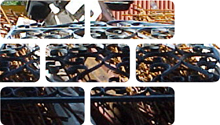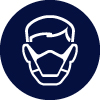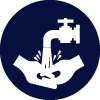
Wrought Iron Metal 17 04 05
Wrought (worked) iron is a tough, malleable and ductile iron alloy which contains fibrous slag that give a grain-like appearance when it is etched or stressed to the point of failure. A foundry would often include pig iron and cast iron as feedstock to make wrought iron, similarly scrap wrought iron would be included in cast iron to improve the casting process. Wrought iron was commonly used as a feedstock for steel up to the 20th Century to produce swords, axes, chisels, cutlery and other edged tools. It was also used to produce rivets, nails, nuts, bolts, roof truss straps, horseshoes, wire, chains, water/steam pipes, handrails, guard rails, furniture, gates, ironclad warships, rails, railway items, bridges, anchor chains, architectural items and ornamental ironwork. They were made of varying quality and finish to suit a range of structural, practical, military and architectural finishes. Wrought iron products are often sought after by the reclamation industry and can be of great value, both financially and historically. Some wrought iron items will be of heritage value and must be preserved, as identified in the site survey.
Usage & Probable Locations
Wrought iron used in the construction of buildings was mostly for non-structural, architectural or functional purposes. It was used for heating pipes, fencing, gates, window and door furniture, garden furniture, architectural features and ornamental displays. It is commonly found in, on or around older houses, Victorian and Georgian estates, stately homes, pre-war hospitals, civic buildings, churches, public spaces and specialist gardens. Works in harbours, military establishments, churches, hospitals, railways and archaeological digs may discover wrought iron artefacts, weapons and items that must be recorded and issued to the appropriate authority. Most wrought iron products, materials and items not of heritage value will be of great interest to the reclamation industry and are often valuable.
Personal Protective Equipment
PPE requirements indicated are for guidance purposes only. DRIDS has identified the PPE that is mandatory on all demolition projects and ones that may be required subject to site specific Risk Assessment & Method Statement (RAMS). Hover over the icon to determine the types of PPE required for the removal of this material.
Removal, Segregation & Storage
Wrought iron products that are destined for reuse should be reclaimed, deconstructed, segregated and stored carefully and safely, to ensure their integrity and good condition. Wrought iron products of historic value should be recorded and issued to the appropriate authority. Wrought iron products, features and items should be stored on a suitably sized pallet or crate, preferably with packaging or straw and covered in shrink-wrap to prevent damage. They should also be stored away from plant movements. Wrought iron materials and broken items should only be recycled as a last resort and should be stored in metal recycling skips.
Tools
Fixtures, Fittings & Connections
Wrought iron products have been traditionally fixed in place with nuts & bolts, rivets, screws, nails, lead, mastic, bitumen, tar, mortars, mechanical joints or studs. Some products such as garden furniture and some architectural and ornamental items have no fixings, rather they will be free-standing or may be built-into or atop stone and brick walls. Some items will often be painted or coated in other decorative finishes. Care should be taken with some wrought iron items which may be sharp. Wrought iron items, features or displays that are of historic value should be reclaimed and recorded, as determined by the site survey.
Health & Safety
Subject to task-specific Risk Assessment & Method Statement (RAMS). Use correct protective equipment for removing bolts, screws, nails, mechanical fixings and mortar. Wear gloves when handling wrought iron products and items with damaged edges, coated in paints or that have been used for plumbing or heating to prevent irritation, cuts and iron shards. Wear eye protection when using hand tools. Only use harness protection at height as a last resort. Only use 360 plant, attachments or cutting tools if properly trained. Use appropriate respiratory protection equipment with a cutting torch.
















